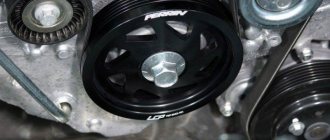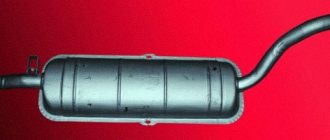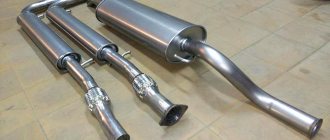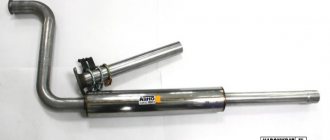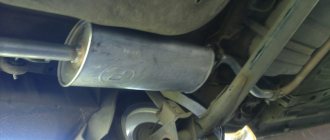Without a high-quality exhaust system, a modern car would sound no different from a tractor. The problem is that any engine will make loud noises during operation, as explosions occur in its cylinders, due to which the crankshaft rotates.
Moreover, the power of the internal combustion engine depends on the strength of these micro-explosions. Since the combustion of the air-fuel mixture releases harmful gaseous substances and a large amount of heat, each car is equipped with a special system for removing gas from the engine. Its device includes several elements that are similar to each other. The muffler and catalyst were discussed in separate reviews. Now let's look at the features of the resonator.
What is a muffler resonator?
Externally, the resonator resembles a smaller version of the main muffler. This part is located at the beginning of the car's exhaust, right after the catalytic converter (if your particular car model has one).
The part is made of steel, which must withstand high temperatures. The gas coming out of the engine exhaust manifold is very hot and moves in an intermittent flow. The resonator is one of the first elements that stabilizes the exhaust. Other parts are responsible for cleaning combustion products, or rather neutralizing them, for example, in diesel engines it is a particulate filter, and in most gasoline engines it is a catalytic converter.
Since burnt gases have a high temperature, a car resonator is made of metal that can withstand high heat, but does not deform or lose its strength.
The catalyst takes care. About ecology
The photo shows a muffler, which is necessary to remove exhaust gases
Another function of the muffler is to remove toxic gases away from the eyes, away from the car body. Attempts are also being made to reduce the level of toxicity of exhaust gases using a muffler. This is what the catalytic converter, the catalyst in everyday life, does. In fact, it does not reduce anything there and does not clean the exhaust gases, much less ozonize them. It simply calculates the CO level and instructs the electronic control unit to adjust the proportion of fuel and air so that there are as few harmful substances in the exhaust gases as possible.
By doing this, it comes into some conflict with the fuel system, which tries to provide maximum power and fill the cylinders with the working mixture, and the catalyst had this power in mind. The main thing for him is to reduce harmful emissions. Catalysts are divided according to their level of influence and the level of stringency of emissions controls. If Euro 2 systems had only one oxygen sensor, a lambda probe in the exhaust pipe of the muffler, then the Euro 3 system is already equipped with two lambda probes, and the higher the Euro safety class, the more noticeable the impact of the catalyst on engine operation.
https://youtube.com/watch?v=V34dOZ5BHs0
The CO level control system is becoming more complicated every year, but for some reason the planet Earth is not becoming cleaner. But catalytic converter systems are becoming more and more expensive and cutting them out of the muffler is becoming more and more difficult. So, on an injection VAZ 2107 or 2109, it was enough just not to be lazy and cut out the stock flame arrester, which was quite choking the engine. Engines 2109, 2114, 2110 of the first years of production complied with Euro 2 standards and there was only one lambda probe in the exhaust system. He only controlled the situation in the area of the exhaust manifold up to the entrance to the exhaust pipe of the muffler. What happened there next, the catalyst could not control. The Euro 3 system requires the installation of two sensors, so later Kalina, Priora, Grant engines are no longer so readily amenable to surgical intervention.
The history of the appearance of the resonator in the exhaust system
With the advent of the first internal combustion engines, the issue of noise reduction and exhaust purification became acute. At first, exhaust systems had a primitive structure, but over time, to increase the efficiency of the system, various auxiliary elements were added to it.
In the first half of the 1900s, a small metal flask with baffles was added to the exhaust system, against which hot gases hit, resulting in reduced exhaust noise. In modern machines, resonators have different shapes and designs.
General meaning
Mitsubishi Galant American, AT Logbook Replacing the muffler pipe gasket Fa1 740-908
Those who conceived and invented the first cars used mufflers of the so-called direct-flow operating principle.
Over time, such exhaust systems began to become a thing of the past, and leading American and European manufacturers came up with a more complex mechanism. Unlike direct-flow exhaust, it made it possible not only to reduce the noise level that the engine produced during operation, but also to reduce the toxicity of gases emitted into the atmosphere.
In general terms, the operation scheme of a modern exhaust system is much more complex than in the case of the direct-flow type, and therefore has several working elements at once, each of which, in turn, has a rather complex design. Their constant interaction makes it possible to significantly reduce noise, increase environmental friendliness and even reduce fuel consumption, which especially significantly affects the owners’ wallets and their desire to own a particular passenger car in the future.
What is it for?
The main function of this element, like that of a muffler, is to reduce the exhaust noise level and divert the flow outside the car body. The burnt gases leaving the engine have a high temperature, so the presence of volumetric parts allows you to reduce this indicator to a safe value. Thanks to this, people walking very close to the exhaust pipe of the car will not get burned.
The power characteristics of the engine depend on the design of the small muffler. For this reason, tuning sports cars also includes upgrading this part of the exhaust. Some resonator models are involved in cleaning the exhaust from harmful substances contained in the flow.
